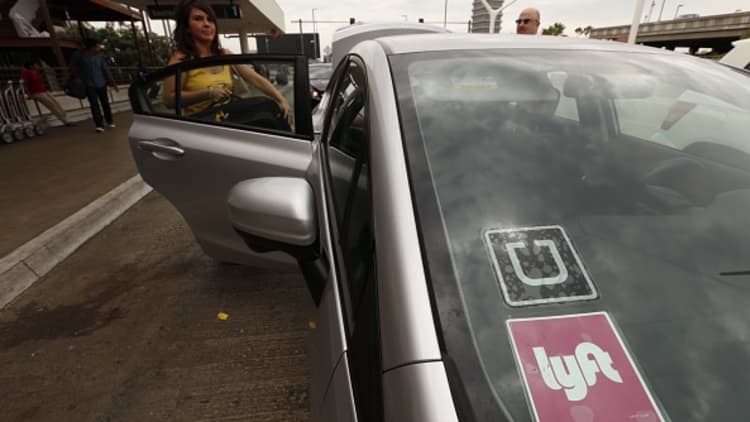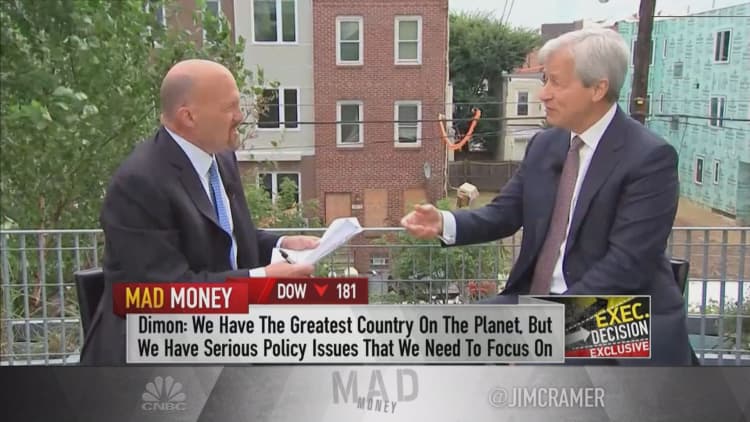Morgan Stanley and Goldman Sachs have long dominated the technology IPO world, with one of them winning the lead spot on almost all of the past decade's biggest offerings. That list includes Facebook, Twitter, Snap and Dropbox.
J.P. Morgan Chase has been a persistent number three. For the largest U.S. bank by assets, that's no longer good enough.
Heading into what's expected to be a blockbuster year for tech IPOs, with Airbnb, Uber, Lyft and Pinterest all potentially on the 2019 docket, J.P. Morgan has a mandate from on high to break up the Morgan Stanley-Goldman duopoly and start nabbing its share of deals.
"We've made huge progress in Silicon Valley," J.P. Morgan CEO Jamie Dimon told a small group of reporters last week at a roundtable discussion in Silicon Valley, where he was surrounded by some of his top bankers in the region.
The bank is aggressively pitching venture capitalists across the Bay Area. One of its main points is detailed on a slide showing that IPOs perform better when J.P. Morgan is at least the co-lead, according to investors who have seen the data but asked not to be named because the discussions were private.
J.P. Morgan is also hiring commercial bankers to service venture-backed startups, specifically those with direct-to-consumer business models, in ways that have typically been left to smaller, more niche firms like Silicon Valley Bank. The strategy is to build relationships with start-ups as early as possible and outmaneuver Goldman and Morgan Stanley to become a tech company's go-to bank.
IPOs are typically underwritten by a number of firms, with each finding investors to buy the shares and then splitting the fees paid by the company. The top bank, recognized by the coveted "lead left" spot on the prospectus, does more of the work around pricing the deal. It also gets paid more than the other firms and positions itself favorably for future transactions after the company becomes public.

For J.P. Morgan, the new strategy is mostly about winning the lead spot on more IPOs, even if that means sacrificing junior positions on some high-profile offerings. So far in 2018, the bank has parlayed longstanding relationships with fuel cell maker Bloom Energy and software company SurveyMonkey into lead spots on their public market debuts.
"We have become very focused," said Madhu Namburi, J.P. Morgan's head of tech investment banking, who was promoted to that position last year. "Instead of trying to coerce every company in the world, we're saying, 'Let's make our bet.'"
J.P. Morgan has won the lead on eight tech IPOs this year, one shy of the cumulative amount of lead lefts over the last three years combined, according to a Goldman analysis of Dealogic data. Still, it's a long away off from Goldman, which has been lead left on more than 40 tech IPOs over the same period — 2015 to 2018.
Landing Lyft's lead left
J.P. Morgan's biggest victory of late was in getting hired to lead Lyft's IPO, expected in early 2019. The second-largest U.S. ride-hailing company could command a $15 billion public market valuation, a person familiar with the company told CNBC last month.
To land the deal, J.P. Morgan spent almost two years focusing on Lyft rather than Uber, said people with knowledge of the matter who asked not to be named because the strategy is confidential. While Uber's public offering will likely be much bigger and command significantly higher fees, J.P. Morgan is betting that it will be Lyft's ongoing bank for secondary placements, financings and acquisitions.
Similarly, J.P. Morgan won the lead left role on the SurveyMonkey IPO in September. The following month, rival software company Qualtrics filed its prospectus, with Morgan Stanley in the lead spot and Goldman second.
But even winning the lead on Lyft and SurveyMonkey could be interpreted as settling for what's available rather than competing for the top prizes. Uber dwarfs Lyft with the latest pitch valuing Uber at $120 billion, and therefore will command higher fees. And Qualtrics is bigger, more profitable and growing faster than SurveyMonkey.
There are several high-profile mandates still up for grabs. In addition to the large consumer tech companies eyeing potential 2019 IPOs, Stripe and Slack could also hit the public markets next year. J.P. Morgan has been forging relationships with a number of those companies, aiming to land the lead left on at least one marquee offering, according to people familiar with the bank's plans.
Unseating one of the top two players won't be easy. Over the past three-, five- and 10-year stretches, J.P. Morgan ranks third in tech IPO deal volume, while Goldman and Morgan Stanley have taken turns at the helm, according to FactSet. Those periods cover the financial crisis of a decade ago and the IPO boom of 2011-2012, when Facebook, LinkedIn, Workday and Palo Alto Networks all debuted.
Tech and internet deals over the past decade
| Rank | Bookrunner | Gross Proceeds raised by issuer | % of Total | No. of Transactions |
|---|---|---|---|---|
| 1 | Morgan Stanley | $64.2 bln | 48.67 | 113 |
| 2 | Goldman Sachs & Co. | $52.9 bln | 40.05 | 106 |
| 3 | JPMorgan Chase & Co | $32.4 bln | 24.58 | 94 |
| 4 | Bank of America Merrill Lynch | $24.8 bln | 18.79 | 49 |
| 5 | Credit Suisse | $21.5 bln | 16.33 | 63 |
| 6 | Deutsche Bank AG | $17.4 bln | 13.17 | 51 |
| 7 | Citigroup | $14.5 bln | 11.01 | 45 |
| 8 | Barclays Plc | $13.6 bln | 10.31 | 28 |
| 9 | UBS Group AG | $12.5 bln | 9.47 | 32 |
| 10 | Jefferies LLC | $8.5 bln | 6.41 | 24 |
Source: Source: FactSet
"Goldman Sachs and Morgan Stanley have great people at the top running those teams," said Jeff Richards, a managing partner at venture firm GGV, which operates in Silicon Valley and China. "The IPO market is wide open for a lot of firms to come in and compete, but at the end of day, winning the mandate is all about relationships, and Goldman and Morgan do it really well. What you see is relationships getting cultivated many years in advance of the IPO."
Asked if J.P. Morgan has moved closer to Goldman and Morgan Stanley, Richards said, "I haven't seen it."
One clear strength for J.P. Morgan over its rivals is its sheer size and scope as a full-service bank. J.P. Morgan's market value is nearly $400 billion, more than twice the size of Goldman and Morgan Stanley combined.
At last week's discussion with reporters, Dimon referred to his tech bankers like Namburi as "Navy SEALs," and said the rest of the bank is "like the Army, bringing in the full force to help them." That includes things like cash management and credit.
Better together
J.P. Morgan's strategy goes further than jockeying for lead left.
Namburi also wants to make more money for the bank when it's second on an IPO. In pitching venture investors and later-stage start-ups, J.P. Morgan bankers are showing that when they work as the second bookrunner, alongside Goldman or Morgan Stanley, the stock does better following the IPO.
In such instances, the companies' shares rose an average of 43 percent a week after the IPO and 48 percent over the next month, according to J.P. Morgan's statistics. When Goldman and Morgan Stanley are the two bookrunners, shares rose 25 percent and 28 percent over those stretches, J.P. Morgan says.
J.P. Morgan is using that data to more aggressively push for equal economics when it co-leads a deal.
Typically, the lead left bank takes 50 percent or more of the total fees associated with underwriting an IPO, leaving the junior banks to split the rest. But J.P. Morgan has been demanding an equal or near-equal split when taking the second spot, telling potential clients that there are significant benefits to having two banks that are equally motivated on a deal rather than just one, according to people who have been pitched by the bank.
There have been 11 tech IPOs with equal economics in 2018, and J.P. Morgan has been involved in six of them — SolarWinds, Bloom Energy, Adyen, GreenSky, Ceridian and Cardlytics, according to the bank.
Those stocks have jumped about 30 percent on average in the first week and 51 percent in the first month of trading, according to a document that J.P. Morgan provided to potential clients and CNBC obtained. When deals don't have equal economics, they trade up 27 percent in the first week and 26 percent in the initial month, the document says.

But data from Goldman tells a different story.
If you count all tech IPOs starting from 2015, equal economics actually lead to worse results a month after IPO, Goldman says, while deals with the largest fee spreads between lead left and junior banks perform the best. Goldman typically pushes this "driver/passenger" model and says deals work best when a single bank has the bulk of the control.
The real test for J.P. Morgan will be in taking its model up against its peers and showing it can win the top-tier deals. Dimon expects nothing less. He's made technology a major priority, frequently meeting with venture capitalists and tech entrepreneurs, letting clients access the company's software to streamline various types of banking and even committing to a new financial technology campus for 1,000 employees in Palo Alto, one of the most expensive real estate markets in the country.
Namburi knows that Dimon and top leadership is giving him whatever he needs.
"For the companies where we make our bet, we bring our firm's full resources to bear," he said.



